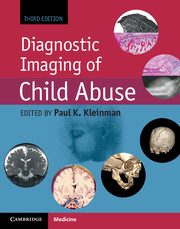Book contents
- Frontmatter
- Dedication
- Contents
- List of Contributors
- Editor’s note on the Foreword to the third edition
- Foreword to the third edition
- Foreword to the second edition
- Foreword to the first edition
- Preface
- Acknowledgments
- List of acronyms
- Introduction
- Section I Skeletal trauma
- Section II Abusive head and spinal trauma
- Section III Visceral trauma and miscellaneous abuse and neglect
- Section IV Diagnostic imaging of abuse in societal context
- Chapter 24 Psychosocial considerations
- Chapter 25 Child abuse and the law I: general issues for the radiologist
- Chapter 26 Child abuse and the law II: the radiologist in court and fundamental legal issues
- Chapter 27 The radiologist's response to child abuse
- Section V Technical considerations and dosimetry
- Index
- References
Chapter 27 - The radiologist's response to child abuse
from Section IV - Diagnostic imaging of abuse in societal context
Published online by Cambridge University Press: 05 September 2015
- Frontmatter
- Dedication
- Contents
- List of Contributors
- Editor’s note on the Foreword to the third edition
- Foreword to the third edition
- Foreword to the second edition
- Foreword to the first edition
- Preface
- Acknowledgments
- List of acronyms
- Introduction
- Section I Skeletal trauma
- Section II Abusive head and spinal trauma
- Section III Visceral trauma and miscellaneous abuse and neglect
- Section IV Diagnostic imaging of abuse in societal context
- Chapter 24 Psychosocial considerations
- Chapter 25 Child abuse and the law I: general issues for the radiologist
- Chapter 26 Child abuse and the law II: the radiologist in court and fundamental legal issues
- Chapter 27 The radiologist's response to child abuse
- Section V Technical considerations and dosimetry
- Index
- References
Summary
Scientific conclusions are subject to perpetual revision. Law, on the other hand, must resolve disputes finally and quickly.
Justice Harry BlackmanDaubert v. Merrell Dow Pharmaceuticals Incorporated.113 U.S. Supreme Court 2786 (1993) (1, 2)Introduction
The traditional role of the diagnostic radiologist to supervise, evaluate, and reach conclusions regarding imaging examinations is generally performed with a sense of confidence, based on experience and a reasonable familiarity with the medical literature. When radiologists identify abnormalities in cases of suspected physical child abuse, they may be drawn from their relatively sheltered world of diagnostic imaging into a potentially daunting realm of child protection/welfare agents, law enforcement officers, and representatives of the courts (3–11). Because allegations of child abuse usually focus on the injured child's caretakers, the customary relationship between the radiologist and the patient's family may be fundamentally altered. In this sensitive area where a thorough and methodical imaging analysis is essential, the radiologist may be hampered by anxieties over involvement with societal institutions that function to protect the welfare of the child and to identify and prosecute individuals responsible for the injuries.
The three preceding chapters have described the societal context in which the radiologist dealing with cases of suspected child abuse must function. The goal has been to give factual information and guidance regarding the legalities in cases of alleged abuse. In this chapter, I would like to provide a personal perspective based on a career operating in this challenging arena. The opinions presented here reflect my own experiences and observations and are by no means applicable to all individuals and situations.
- Type
- Chapter
- Information
- Diagnostic Imaging of Child Abuse , pp. 658 - 664Publisher: Cambridge University PressPrint publication year: 2015
References
- 2
- Cited by



